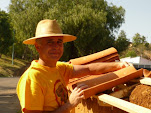En Internet encontré "Tadelakt", una técnica de Marruecos para crear recubrimientos de cal muy bonitos y casi impermeables. Se pule y bruñe un repello de cal con una piedra muy lisa. Posteriormente se sella con una capa de "savon noir" (jabón negro).
In the internet I found "Tadelakt", a technique from Morocco to create beautiful and almost waterproof lime plasters. A thick lime plaster is polished and burnished with a very smooth stone. Then it is sealed with "savon noir" (black soap).
 |
| Imagen tomada de / Image taken from https://www.nomadbubbles.com/tadelakt-marruecos/ |
¡Manos a la obra! Usé la pasta de cal que pigmenté en "color pastel durazno".
Hands to work! I used the lime paste pigmented earlier with a "pastel peachy color"


¿y qué es el "savon noir" con que se recubre el repello de cal? Encontré versiones contradictorias en internet: jabón con aceite y pasta de olivo, o hecho de particulares pescados marroquíes , o con aceites de eucalipto. Dada la confusión, hice lo que me dictó el sentido común. Combiné jabón común con aceite de oliva.
And what is the "savon noir" used to seal the lime plaster? I found some contradicting versions in internet: soap with olive oil and paste, or made of a particular Moroccan fish species, or with eucalyptus oils. Given the confusion, I used common sense. I combined plain washing soap with olive oil.
Resultó una pasta viscosa con la que embadurné el repello.
A thick slimy paste was the result. I used it to daub it to the plaster.
El resultado fue "no malo", pero no me dejó feliz.
The result was "not bad", but I am not happy.
Me aventuré a "tadelaktear" todo el cubículo del lavabo. Preferí hacerlo sin pigmento. El resultado fue un poco mejor.
I ventured into "tadelakting" the small space that houses the sink. I decided to do it without pigment. The result was slightly better.
¡Incluso hay algunas áreas que brillan!
Some spots are even shiny!
Necesito seguir practicando la pigmentación y la técnica...
I need more practice in the pigmentation and the technique...

Apliqué esta pasta en un área pequeñita, abajo del lavabo para hacer pruebas. Así no se verá si queda fea. Pulí la superficie con una espátula metálica.
I applied this paste in a small area, below the sink, to do some tests. It will remain hidden, so no problem if it turns out ugly. I burnished the surface with a steel spatula.

And what is the "savon noir" used to seal the lime plaster? I found some contradicting versions in internet: soap with olive oil and paste, or made of a particular Moroccan fish species, or with eucalyptus oils. Given the confusion, I used common sense. I combined plain washing soap with olive oil.
Resultó una pasta viscosa con la que embadurné el repello.
A thick slimy paste was the result. I used it to daub it to the plaster.
El resultado fue "no malo", pero no me dejó feliz.
The result was "not bad", but I am not happy.
I ventured into "tadelakting" the small space that houses the sink. I decided to do it without pigment. The result was slightly better.
¡Incluso hay algunas áreas que brillan!
Some spots are even shiny!
Necesito seguir practicando la pigmentación y la técnica...
I need more practice in the pigmentation and the technique...







What would you recommend for beginners???
ResponderEliminarTo make some tests and practice in spots that will remain out of sight. When you start, it is a little bit tricky to achieve flat surfaces that are also water resistant!
EliminarAlso ist Dir der Tadelakt im ersten Akt nicht ganz ohne Tadel gelungen... bin über die weitere Übung mit farbigem Tadelakt gespannt!
ResponderEliminarIn weiß sieht das natürlich strahlend schön aus :)
Vielen Dank für die aufmunternde Kommentare. Und Ja: dieser erste Versuch war nicht Tadel-los, auch nicht Tadel-voll und schon gar nicht Tadelakt!!!
Eliminar